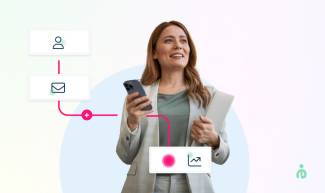Unsure How To Retarget Leads? Here’s Your Fix.
We can’t speak for you, but every business at some point has hit that rock bottom—that marketing low that is all too often signposted by the inverted relationship between their retargeting efforts and desired business outcomes (in terms of conversions.)
It’s that real. And NO. This has nothing to do with a god-awful marketing department or a lean ad spend, but more to do with a know-how gap on locating that sweet, delicate spot to significantly boost B2B conversions!
Painfully, businesses find that only a tiny proportion of leads gets converted to actual sales. Picture this: their conversion/sales funnel — an inverted (triangular) funnel depicting how the audience gradually tapers down from the awareness stage down to the stage of the actual sales, revealing that some prospects are 'trapped’ in certain stages within the funnel.
It’s not all grim. These ‘abandoners’ (as often so-called by folks in marketing) will stagnantly remain in your pool of prospects. This is OK because now you no longer have to start at the very top of the conversion funnel when they were absolute strangers!
With the little data that you may have about them, now you’ve got the chance to design ad campaigns that’ll speak more directly to their pain points and possibly win them over.
This is the core of retargeting.
This post talks about the technical art of retargeting in the B2B sphere, how to apply it, and several other tidbits that you should know. We’re trusting that at the end of this financial year, you’ll be grateful for gainfully grasping all there is to successfully retarget and convert prospects!
First off, Why Retargeting?
Ever heard of the ‘marketing rule of 7’? It’s an old marketing maxim in the American ad industry. According to this rule, it takes (on average) about seven interactions with your brand before a potential prospect can finally be converted.
This is also by no means an all-encompassing rule, and it’s even thought by many to no longer hold true as it did some two decades ago, considering the splendor of advertising options available to modern advertisers.
Nevertheless, its central theme continues to remain relevant—that the average individual will most certainly NOT convert on the very first contact they have with your business. Given this, it’ll likely take more instances of ‘interaction’ to seal a conversion.
Because retargeting emails are triggered when a prospect visits your site (and you know that they're already interested in your product), these messages have an extremely high open rate.
This is why retargeting should be the lynchpin of your B2B marketing strategy.
What is B2B Retargeting?
B2B retargeting is a type of online advertising that allows marketers to strategically market their services or products to individuals that have already visited their website. It provides audience segmentation options that are based on keywords, demographics, geolocation, and site-interaction data.
As algorithms use past website behaviour and interactions, marketers can reach their target audience with more accuracy, helping companies stay top of mind with potential clients that have been educated about a company's offerings but haven't yet made up their minds just yet.
This allows businesses to convert leads into sales and establish themselves as industry influencers. In B2B, Emails are the preferred tool for retargeting.
Not only are retargeting emails simple and a perfect fit for inter-company communication in a B2B relationship, but they are also a highly flexible tool, offering more personalisation options than most other advertising media.
How Does Email Remarketing Work?
Email retargeting is a digital marketing tactic used to reintroduce products or services to potential customers who already started out on your conversion funnel but never converted.
The allure of email targeting lies in the interest your audience has previously indicated in your brand. Interest can be communicated through subtle hints like inputting their email addresses, subscribing to your newsletters, etc.
This segment of people only needs little convincing compared to people who’ve got absolutely no knowledge about your brand. For this audience segment, email retargeting was found to be successful by researchers to increase conversion rates by almost 150%.
When Can You Apply Email Retargeting Techniques?
If you’ve read until this point, you already know that email retargeting is a highly specialised marketing tactic. For best results, it should be done at specific points within the customer lifecycle.
Below, we outline a few instances where you can whip out some email retargeting tricks out your marketing sleeves:
- Reconnect/Recapture old prospects
One of the best uses of email retargeting is in reconnecting with and recapturing old leads. There are many reasons for which a business could initiate contact with yours. And as explained in the marketing rule of 7, most of the time, these first contacts do not convert. Frequently, they just fade into the background immediately after the first contact.
But, by merely contacting you, they have declared some interest, and with only a little bit of prodding, can be persuaded to convert. With email retargeting, you can send periodic emails to this class of customers, reminding them of the products or services that you offer and what they stand to gain from using them. You may also introduce discounts or other promotional offers to sweeten the deal.
- Warm Up your Cold Leads
Existing leads are prospects actively in any stage in the conversion funnel. Segmenting this class based on where they are in the funnel, you can send targeting emails to guide them through the funnel, convert, and become loyal customers.
By making sure they see your emails, you remind prospects about your business offerings, and this increases the chance they come back and make a purchase. Retargeting works just like bringing back (or ‘heating’) the cold lead trail.
- Remarketing to already-converted customers
Email retargeting is also helpful in remarketing to customers who have already bought one or two products or services. Businesses in this category have already demonstrated trust and loyalty to your business.
You can take genuine advantage of that with retargeting to help them reach optimal user experience, clocking in more sales. It could come either by way of cross-selling or upselling.
Cross-selling involves pitching products or services similar and complementary to what they’ve already bought, while upselling involves pitching an upgrade to a higher version of the product that they already purchased.
How To Leverage Retargeting Emails to Increase B2B Conversion
B2B marketers face a persistent challenge: getting prospects to respond to email marketing campaigns developed with critical decision-makers in mind. Multi-touch buying processes mean that these contributors to the buying process are often not first-time buyers. As a result, marketers send emails with highly relevant content for each decision-maker involved in the buying process.
The challenge is to avoid having those emails get lost among the other marketing messages flooding prospects' inboxes every day. Retargeting emails is the answer.
Retargeting emails are usually the most powerful way to retarget people that have just visited your website or added some items into their cart. And that also includes visitors that are leaving your site without buying at all. All you have to do is figure out what content is (based on the data you might already have at hand) most likely to attract and persuade them to convert.
These few tips below will show you how to properly use emails to retarget leads:
- Build an email list
Your first line of action would be to build a retargeting email list. At the beginning stages of the sales funnel, you can obtain emails from prospects offering updates, promotional offers, newsletters. Get creative. Just about anything will do.
- Segmentation
Next, you want to segment your email list. Personalisation is a huge part of email retargeting, so this part is very crucial. It’s how you get to send personalised emails that align with the specific conditions of each group of subscribers.
For instance, there should be different segments for subscribers who’ve purchased a product at least once and subscribers who haven’t.
- Marketing rule of 7
Earlier in this article, we explained the marketing rule of 7. And even though the number (7) might no longer be accurate, it’s still vital that you initiate contact with your prospects multiple times to give them a bit of a nudge.
If they do not respond to the first email, then they’re more likely to respond more favourably to a second one, a third one, or fourth: the more retargeting emails you send, the more your chances of making conversions.
- Space it out
We all know how it feels to be at the receiving end of a barrage of non-stop marketing retargeting emails. In case you didn’t know, recipients find it terribly unpleasant, quite intrusive, and flat-out pesky! So, it usually does not even achieve the goal, as all too often, further emails from the sender may then be redirected to—you guessed—spam!
That said, developing a template for spacing your emails out should be a critical part of your email retargeting strategy. You should seek to set a time interval that is respectably long enough for your retargeting emails not to be a bother and time correctly to keep the recipients’ interests in your products alive.
You can send personalised automated campaigns based on when they were sent, the link prospects clicked in the past, and other factors.
- Enticing offers
Promotional offers are one marketing tool that has stood the test of time. People are hard-wired to pay more attention when they feel like they’re in for a bargain. And even though you might be in the B2B segment, business entities themselves don’t read or send emails. It eventually falls to an individual who can be persuaded, just like in B2C.
With just the right offers, you can win them over. So, set about finding the perfect offers for the subscribers on your list. Discounts may not be enough to do the trick, but there are many other juicy offers that can!

Our Conclusion
Studies suggest retargeting could increase conversion rates up to a whopping 150%.
The pool of businesses who have already had first contact with your business present endless potentials for sales conversions and for remarkably less than you would spend trying to convert first-time contacts. With a well-structured retargeting strategy, you can upscale revenue off this super-valuable segment of audience alone.
Your retargeting campaigns—if fuelled with relevant ads—can also expect a higher ROAS (return on ad spend) since your leads are no strangers to the brand!
With this floating at the back of our minds, if your entry into this post was ushered in by thought patterns like “why retarget? I mean, why beat a dead horse?” we’re here to flip the switch on your pessimism and crown you with some valid, bright optimism.
What more? Loadssss! Really. By degrees, Apsis One has emerged as the B2B partner of choice for digital marketers. And the reason isn't hard to tell. Apsis One poured its soul into curating a suite of highly specialised tools that make the B2B world your oyster! Whether your B2B company offers Products or Services, we just want you to have a gloriously rewarding email marketing campaign.
What’s in here for you? Only one way to know! Book a demo for free to see just how we can help you reach your goals, or tap into our resourceful handbook on how the modern marketer can successfully navigate email marketing!


